
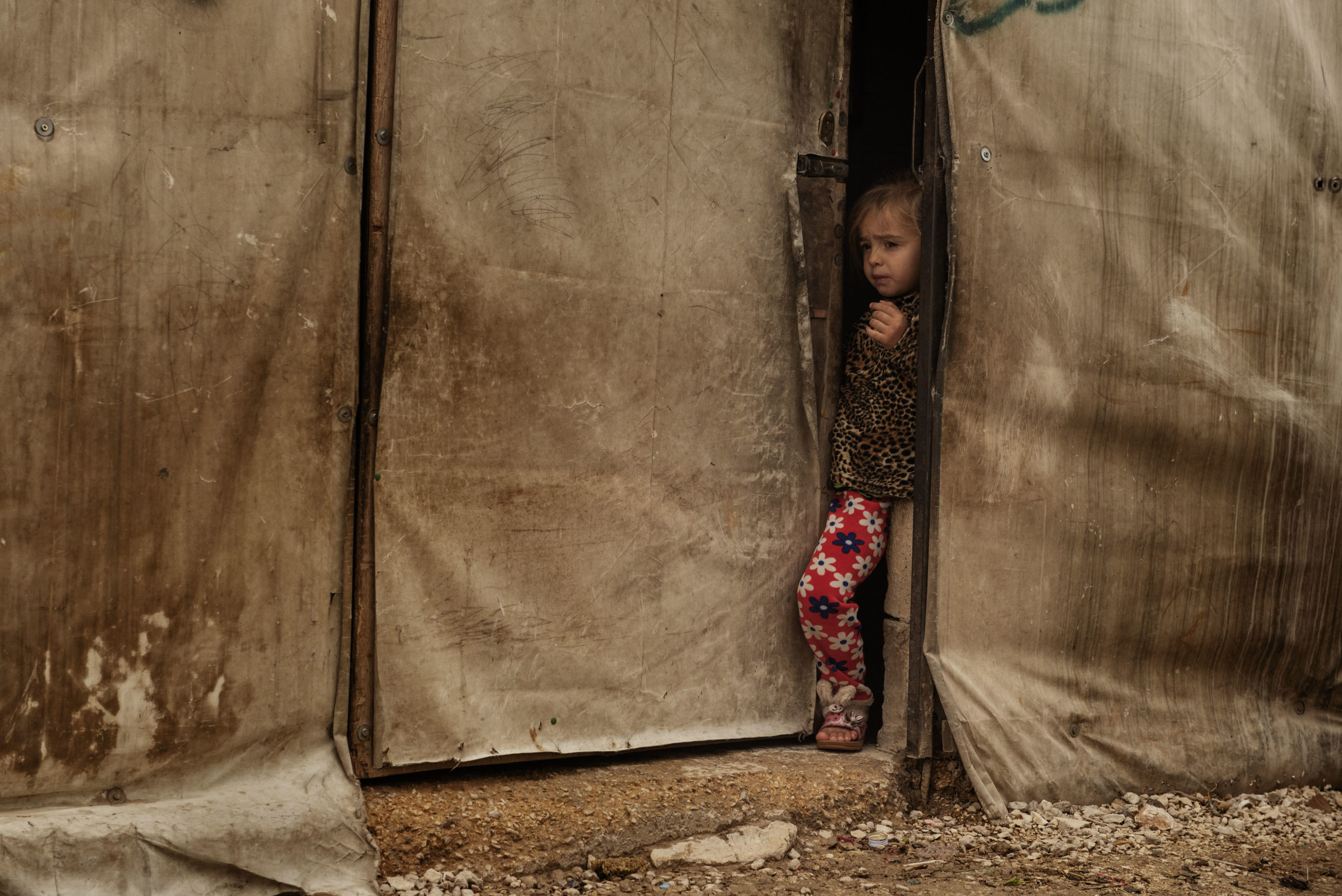
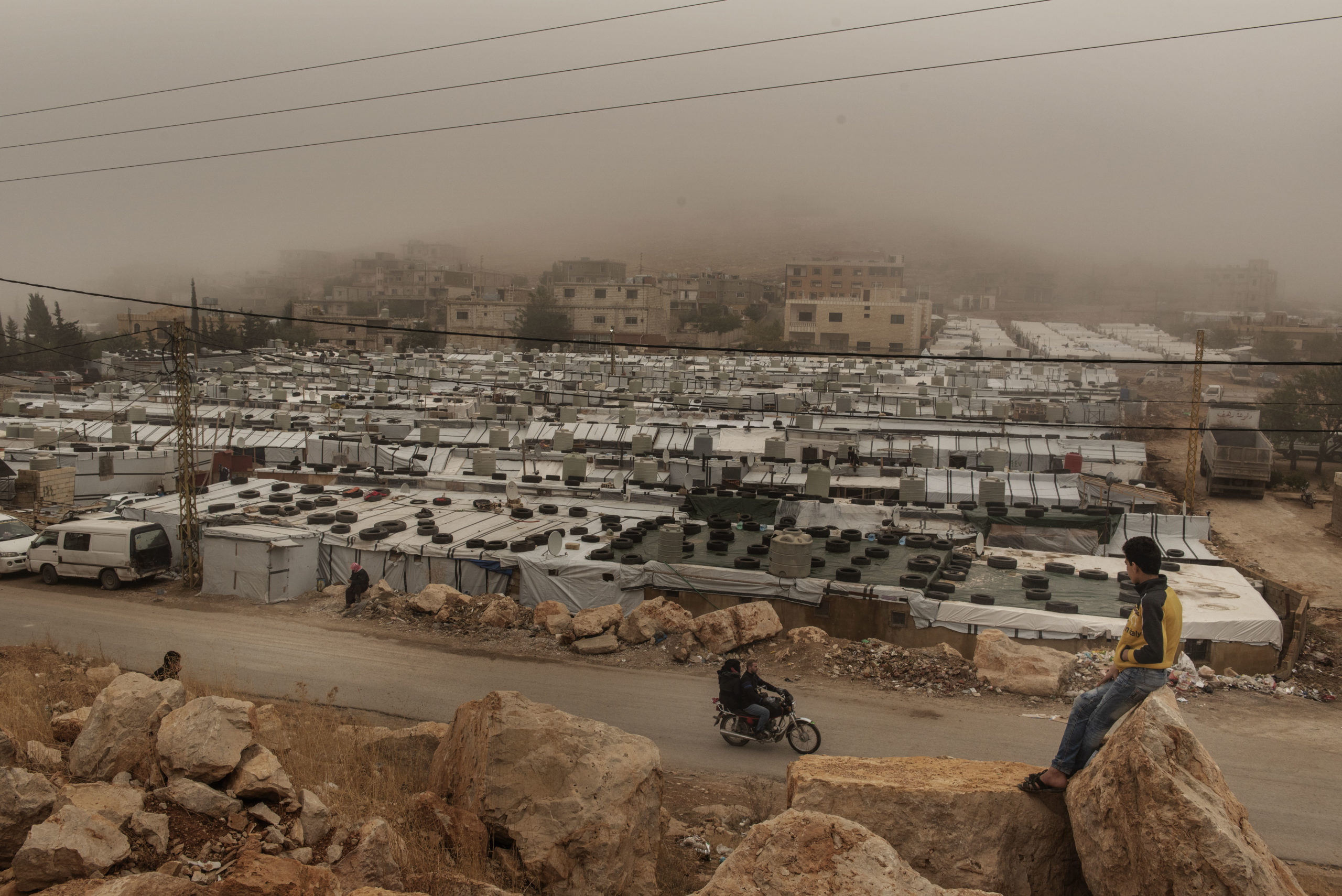
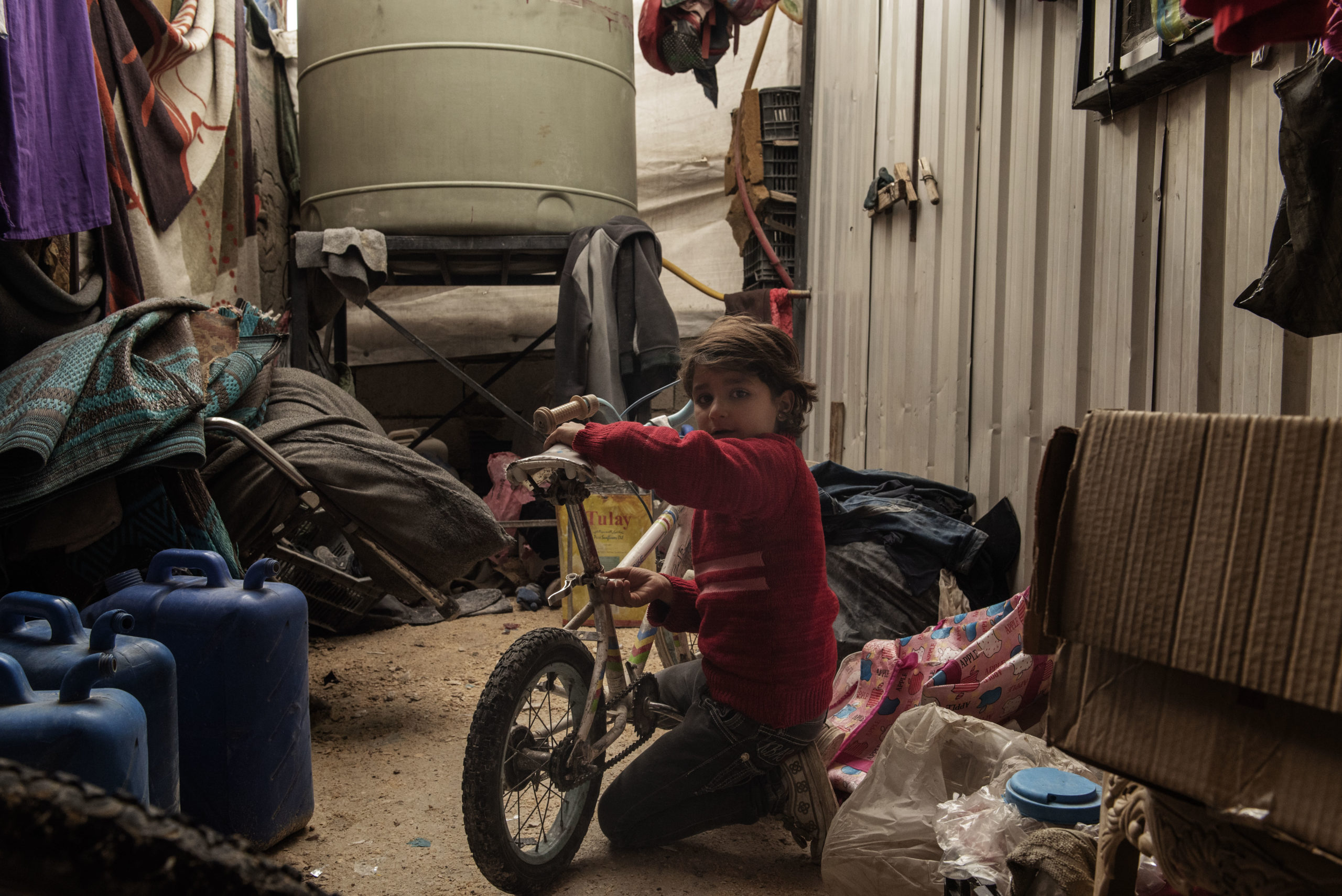
“I Think About Home Every Day”: The Syrians Who Can Never Return
Beset by winter and within sight of their former homes, Syrian refugees live on hope in an increasingly inhospitable Lebanon
Last November, a man set himself on fire in front of the United Nations refugee agency (UNHCR) headquarters in the Bir Hassan area of Beirut. The 58-year-old was unemployed and, according to the Lebanese Internal Security Forces, could not afford medical treatment for his sick daughter. A few weeks earlier in Arsal, in the north of the country, a 60-year-old who had lost his job and could no longer bear the poverty and shame attempted to hang himself. Both men had fled the war in Syria.
Since the beginning of the war, 1 million people have sought refuge in Lebanon — 1 million on paper, that is. Because in 2015, at the request of the Lebanese government, the United Nations stopped counting. According to current UNHCR estimates, the country is home to 900,000 Syrians, but the more likely figure is 1.5 million. This is in addition to some 200,000 Palestinians who have lived in Lebanon for decades, making it the country with the highest number of refugees per capita, constituting a third of its total population of 6.85 million. Integrating them has never been an option.
In Lebanon, power is divided on a religious basis (Sunni, Shiite, Druze, and Maronite are among the 18 officially recognized religious groups). The quotas are based on an outdated census from the 1930s, according to which Christians constitute the majority. The system has paralyzed decision-making, transforming political life into a never-ending communal contest amid endemic corruption.
In this delicately balanced system — a system in which the president must be a Maronite Christian, the prime minister a Sunni Muslim, and the speaker of the parliament a Shiite Muslim — the addition of 1.5 million mainly Sunni Muslims to the population could ignite an already volatile system. This is why the Syrians who arrived in Lebanon are not even considered refugees. Recognizing them as refugees would entail obligations that the Lebanese government is not ready to accept. So they remain mere “guests.”
One consequence is that no real refugee camps have been built for Syrian families, who can only reside in informal encampments. But over time even this temporary tolerance has hardened into a persistent pressure to leave.
The Bekaa Valley remains the center of the Syrian crisis in Lebanon, sheltering half the refugees who live in makeshift tents and shacks. But Arsal, on Lebanon’s northern border with Syria, is a tragedy within a tragedy. The camp is a sea of tents. The United Nations calls them ITS, informal tent settlements, an anodyne abbreviation that disguises the heaps of plastic and scrap metal that prop up shelters for half a million people.
Mohammed Elsoufi lives in one of these shacks. He has an ageless face. Mohammad’s identity card indicates he is 50, but the rigors of life in a tent have engraved themselves on the rest of his body. Like many, he arrived expecting to stay a month or two, hoping that the war would be over soon and he could return with his wife and four children to his home in Homs. Eight winters later, home remains an elusive dream.
The camp where Mohammad now lives is one of Arsal’s 170 informal settlements. Between 600 and 700 people live there, part of the 150,000 Syrians who are currently sheltering in the area. Winter adds sub-zero temperatures to the refugees’ other hardships.
Mohammed’s wife has turned 2 square meters (6.6 square feet) of their tent into a kitchen. She wears a sheet that she has cut in two and sewn as a veil and an abaya, the robe that covers her body.
Before he was forced to flee Syria, Mohammed worked as a carpenter and had built a humble but decent home. The home too, became a casualty of war. His brother, who is still in Syria, sent him photos of the few walls that survive. But Mohammed did not have the heart to see. “What is lost is lost,” he says.
Mohammed’s tent is flooded after hours of winter rain. Most tents have no roofs, covered only by some pieces of wood and plastic. The drainage channels in the settlement are blocked. Water rises and engulfs the tents, creating frigid ponds where children play barefoot. Inside, mattresses are wet and clothes damp. When it rains too much, the channels fill up with sewage.
Yet the stove in the center of Mohammed’s tent is off. Money for fuel was always low, but this year it has been made worthless by inflation. Before the economic crisis in Lebanon, Mohammed was sporadically employed — three or four days a month, as a bricklayer, or in the local quarries. They were paid a quarter of the wage earned by Lebanese workers. Mohammed had little choice but to accept the salary so he could bring home something more nutritious than bread.
First the crisis and then the port explosion added further strains, compounding injustice with exploitation. Some employers withheld salaries, and work opportunities soon dwindled for both the Lebanese and Syrians.
“Until a few months ago, I earned 15,000 to 20,000 Lebanese pounds for one day of work, worth about $13 to $15,” he says. “Today, at the new black-market rate, they are worth more or less $3.”
As cheap labor, Syrians for years were considered part of the crisis. Most refugees are denied legal residence or work permits. They can work legally only in three low-skilled sectors: agriculture, construction, and cleaning. As a result, many find work in the informal sector, where they are vulnerable to exploitation.
“When you have no money, you have to borrow it,” Mohammed explains. “You can eat once a day, but with the snow you need fuel; you need to warm up the tents for the children.”
Over the years, as hardships increase, debts accumulate. The United Nations estimates that 80% of Syrians in Lebanon live below the poverty line.
Omar, Mohammed’s youngest, listens intently to his father. He was 1 year old when they crossed the mountains. He is frail and emaciated, his sweater too small for his age and too light for the temperatures. He coughs repeatedly. Like his mother and father, he sleeps on a damp mattress on the floor. Mohammed doesn’t want him to work; he doesn’t want him to end up like most of his peers with his back bent in the fields picking fruit and vegetables for $2 a day. But Omar can’t go to school because Mohammed can’t afford the transportation cost from the camp to the school.
It would cost 200,000 Lebanese pounds a year to send the child to school, $70 at the current exchange rate. Mohammed doesn’t have such money. Yet he remains stoic, never raising his voice. He talks about the inhumanity of the camps as if the pain did not belong to him. He is weary, but without anger. “We can’t do anything,” he says with a sense of resignation. His deepest pain is the memory of his son, 15, killed by Assad’s bombs as they fled Homs.
Mohammed loses his composure as his wife Ghadir speaks of the boy, and he cries just for a second. He leaves the tent and later apologizes for the intimate pain shared with strangers. Ghadir does not remember the last time she left the camp. Her sister lives in a tent a few miles away in another settlement. She hasn’t seen her in months.
For the refugees in Arsal, the difficulty of life in the camps has been compounded by the lack of security. From 2014, the arid mountainous area of Arsal had been a base for militants linked to Jabhat al-Nusra and the Islamic State. In 2017, Hezbollah gained control of the area in an agreement that ended the armed clashes, and about 8,000 refugees and Jabhat al-Nusra militants were allowed to leave to northern Syria. But the calm did not last. Last year, the Lebanese government ordered the demolition of all concrete structures in the settlements that were more than 1 meter (39 inches) high. This has left refugees under the flimsy protection of wood and plastic sheeting.
“We will return to our home one day,” says Ghadir.
It is hard to tell if the refugees genuinely believe this, or if they are merely articulating a hope that helps them cope with the current nightmare. It must certainly be hard to accept the finality of their condition when what used to be home is less than 20 miles from their tents.
“We will go home, God willing, and Mohammed will still be able to eat kubba, the meat he likes so much,” Ghadir says. They have not been able to afford such luxuries for four years.
Even before the financial crisis and the port explosion, refugees lived on less than $3 a day. Today, aid amounting to $27 per person per month is paid in Lebanese currency, which at the black-market exchange rate is worth $10 to $15 maximum. Even before the crisis, half of Syrian school-age children were excluded from the Lebanese education system. As a result, more than 200,000 children are deprived of an education. The situation has been further aggravated by the closure of informal schools.
In the Arsal region there are 10,000 children of primary school age. The Lebanese public schools, until last year, had room for only 3,000 children. This autumn, the Ministry of Education decided to close informal schools run by nongovernmental organizations that were providing Syrian children, who are excluded from Lebanese schools, temporary education. Over the years, however, these schools, like the tents, had ceased to be transitory, providing the only access to education for tens of thousands. They were not recognized by the Lebanese school system, they did not give certificates, but for many, any education was better than no education. Above all, they were the only alternative to exploitation and child labor.
It is difficult not to read the decision to close informal schools as another attempt by the Lebanese government to discourage Syrians from staying. In a speech last September marking the 75th anniversary of the establishment of the United Nations, President Michel Aoun said: “We ask the world to help us ensure the safe return of the displaced Syrians because Lebanon is suffering from an unprecedented crisis and is now unable to host them.”
This position is not new and is fed by his party, the Free Patriotic Movement (FPM), the largest Christian party in the country. Last year, volunteers from the party’s youth wing started a “Lebanese First” campaign, calling on businesses employing Syrian refugees and non-Lebanese citizens to be shut down. They distributed leaflets asking people to send evidence — photos and videos — to identify such businesses. The flyer read: “Protect the Lebanese, denounce offenders. Syria is safe for their return.”
Over the years, Syrian refugees have become the scapegoat for Lebanon’s ancient, structural problems. Government officials have long exploited their presence for political goals. Prominent among them is Gebran Bassil, Aoun’s son-in-law, a former foreign minister, and president of FPM, which is known for its racist tweets asserting the superiority of the Lebanese people and warning that “the Syrians threaten the identity of our people.” Bassil incited the anti-Syrian campaigns. “It is not racial discrimination but the consolidation of our sovereignty,” he said. “Syrians have a safe home to return to. They were supposed to go back yesterday, they have to go back today, and they have to go back tomorrow.”
In 2018, Lebanon began organizing the return of Syrian refugees despite numerous risks and warnings from humanitarian organizations. The U.S. State Department also intervened, calling the time “not ripe for return.” Months later, the Lebanese government ruled that any Syrian who entered Lebanon illegally after April 24, 2019, could be deported without being tried in court.
The pressure is even stronger now with the Lebanese financial crisis and the port disaster. In early November, Aoun received a Russian delegation to discuss the return of Syrian refugees. Led by the Russian president’s special envoy to Syria, Alexander Lavrentiev, and the Russian ambassador to Syria, Alexander Kinschak, the delegation featured diplomats and, more alarmingly, military personnel. “The time is ripe,” said Aoun.
Abdul Razzak al Abed, who escaped nearby Qalamoun, has lived in Arsal since 2013. His mother and brother signed a declaration of reconciliation with the regime and returned to Syria a year and a half ago. He talks to her often, and she tells him that there is no bread, that life is hard, that a little flour is delivered every week, but never enough. They talk often, but never about politics. It’s too risky.
Abdul, however, can’t risk the same. He knows that for a man to cross the border and return home often means forced conscription or disappearance. This happened to two of his cousins, who are now detained in a Syrian prison; to a relative who was executed; and to a 12-year-old nephew who disappeared the day he entered Syria.
“If you have left Syria, you are automatically considered a terrorist,” Abdul says. “It doesn’t matter if you are a child. This is how the regime works.” He shows us a photo of Ahmad, his nephew. “Go back home? I think about it every day. Every night I fall asleep on a damp mattress. Every day I wear clothes that never dry. And every time I think I haven’t had a shower in seven years. But there is nothing to do,” he says. “Nothing to do.”
Abdul drives through the hills to the highest point in Arsal and looks toward Syria, as if the past were suspended there, visible, yet out of reach. On the nearer side, meanwhile, is a reality he can’t escape: a sea of white tents, everywhere, as far as the eye can see.
“Just beyond the mountains,” Abdul says, “it’s my home.”
Story by Francesca Mannocchi, photographs by Alessio Romenzi for New Lines

Maria, Khadijeh abdl Kader Chaine’s daughter, tries to fix her bike in front of the shelter where she lives/Alessio Romenzi
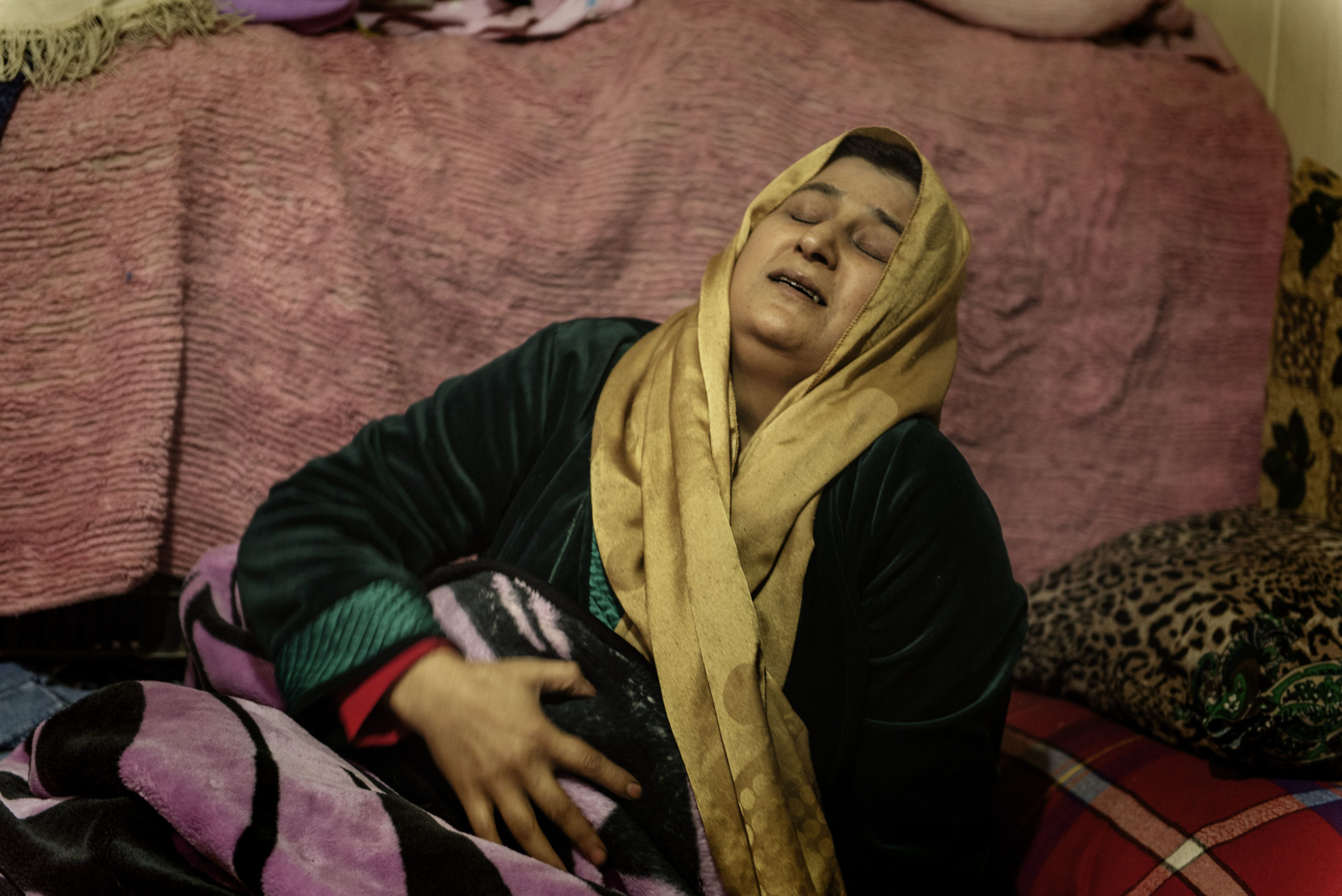
Khadijeh abdl Kader Chaine, a Syrian refugee, has cancer but cannot access treatment in the Lebanese healthcare system/Alessio Romenzi
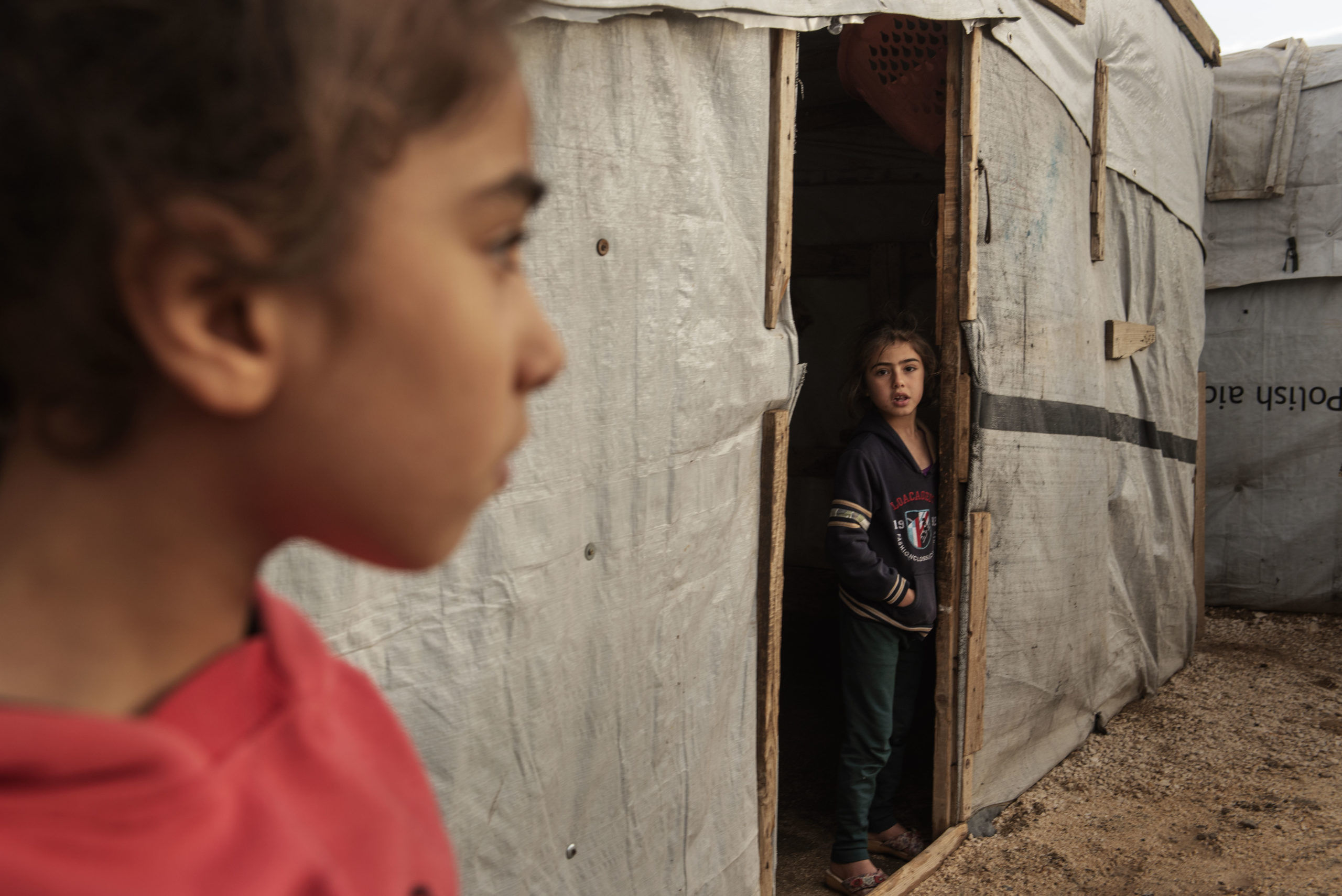
Syrian children in one of the 150 refugee camps scattered around the village/Alessio Romenzi
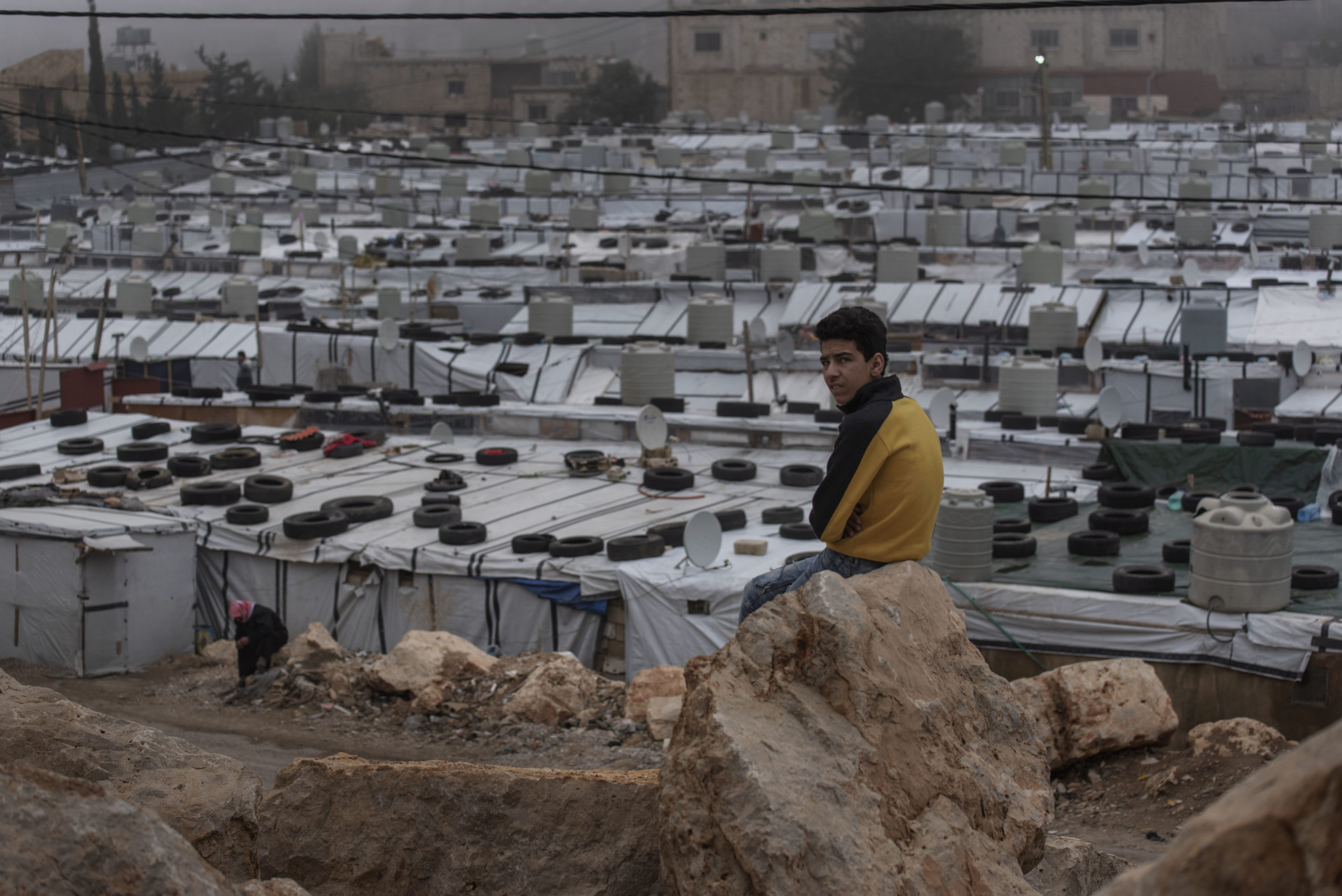
A Syrian boy observes from above the refugee camp where he lives in the village of Arsal/Alessio Romenzi
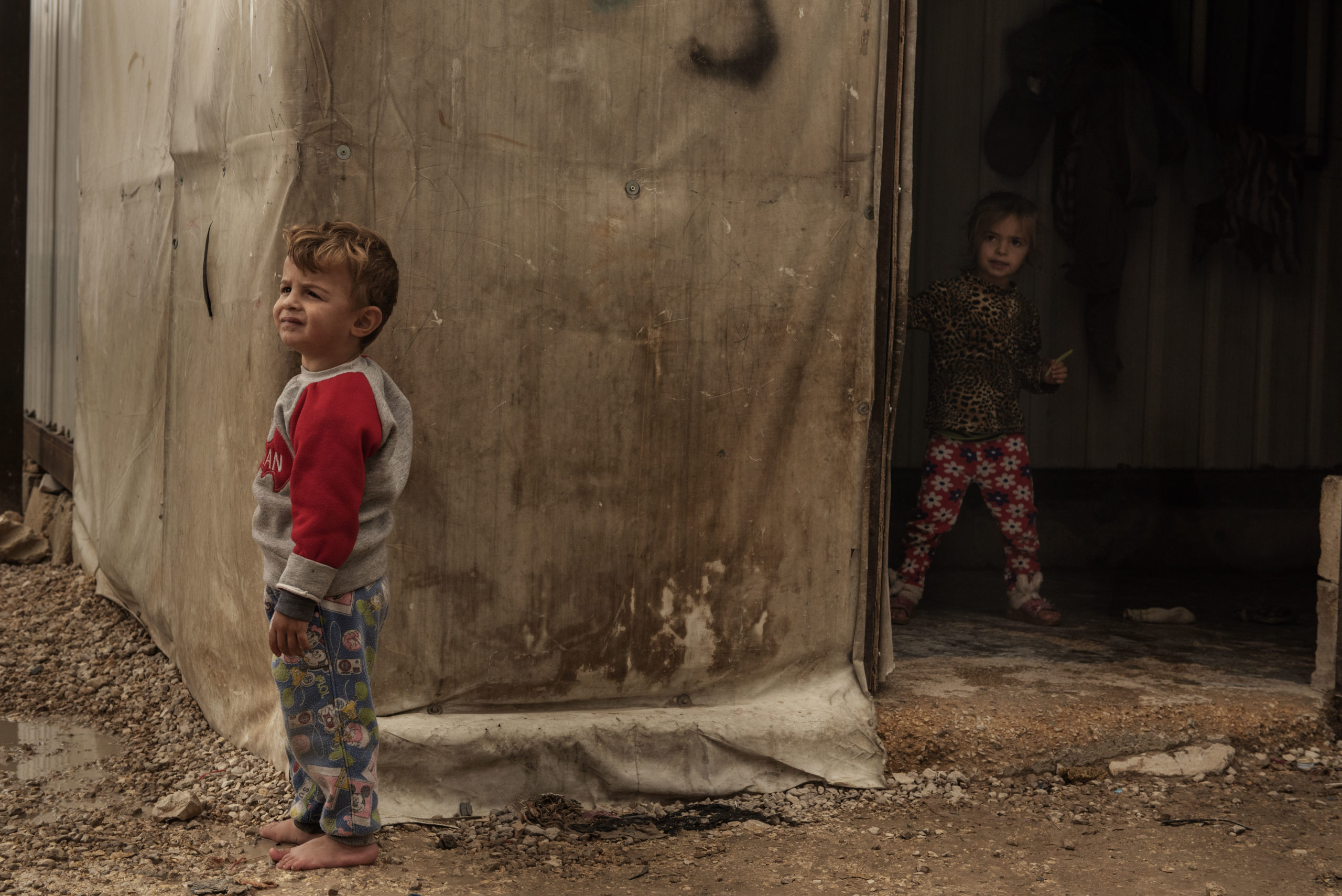
Syrian children in one of the 150 refugee camps scattered around the village/Alessio Romenzi
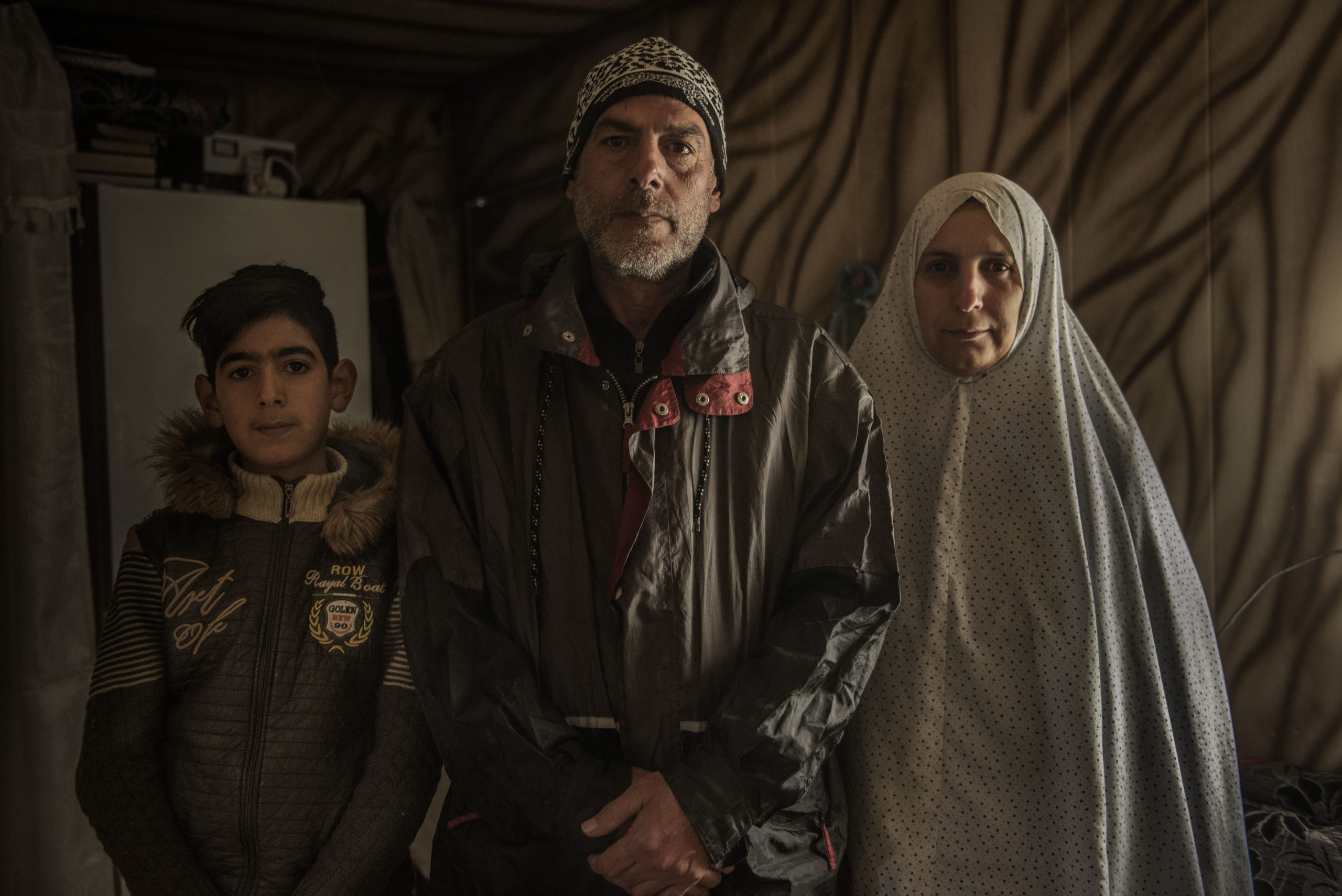
Mohammed and his family pose for a portrait inside the shelter where they live/Alessio Romenzi
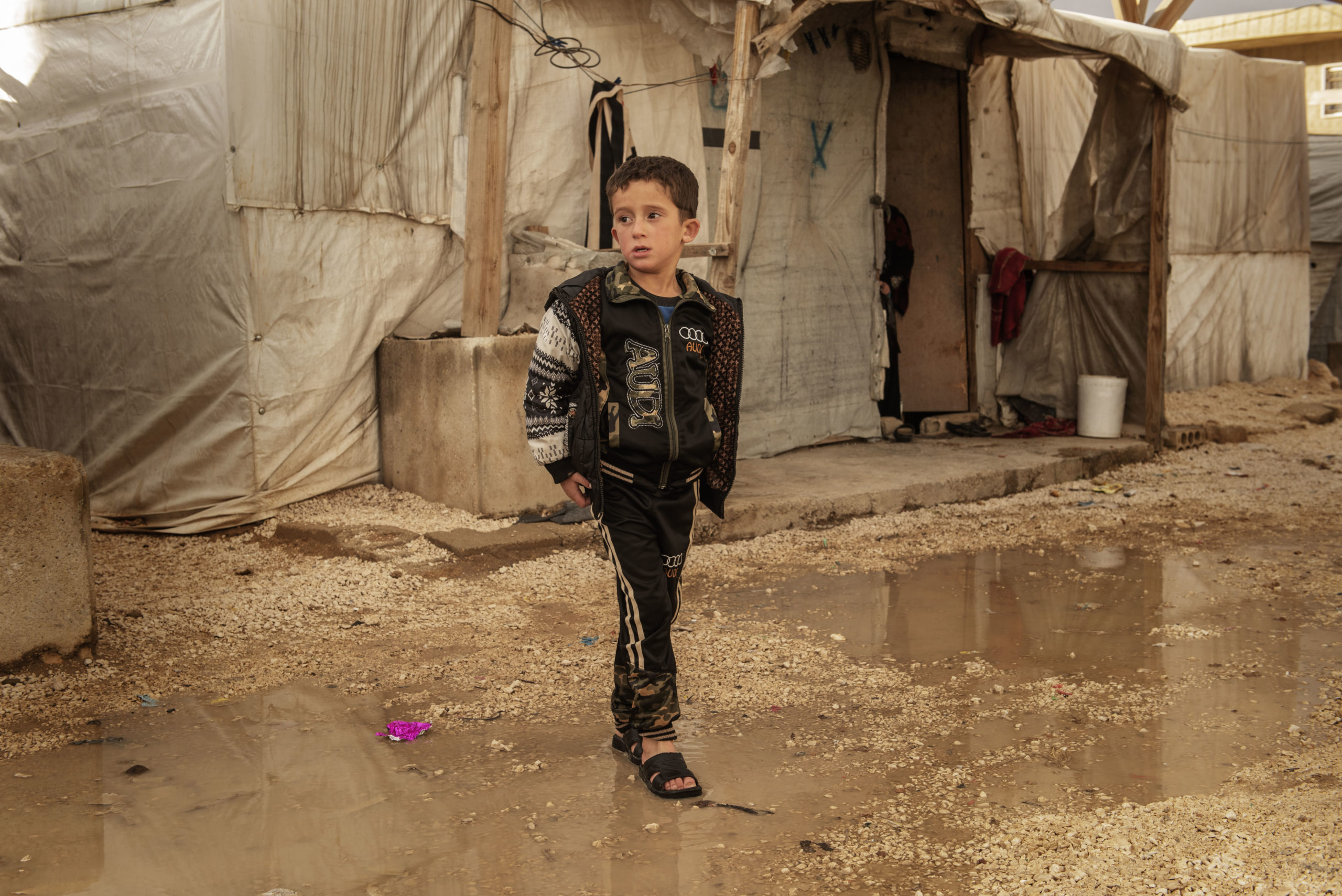
A Syrian child in one of the 150 refugee camps scattered around the village/Alessio Romenzi
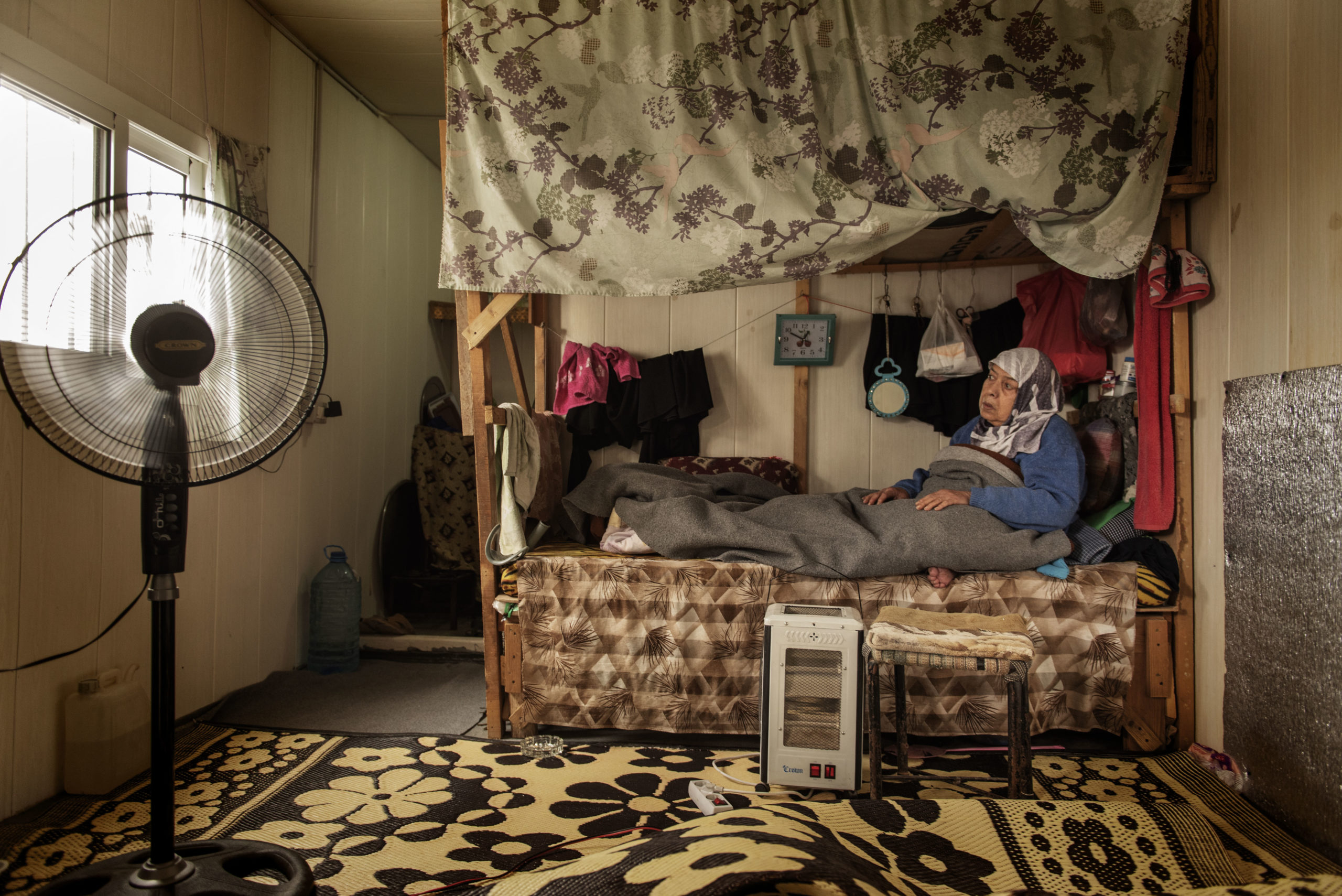
Neifa can barely walk and had to place a fan in her shelter in an attempt to dry the floor that had flooded from the previous night’s storm/Alessio Romenzi



